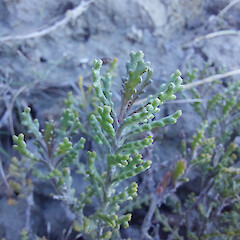Senecio hauwai
Common name
Marfells groundsel, Clifford Bay groundsel
Synonyms
None
Family
Asteraceae
Flora category
Vascular – Native
Endemic taxon
Yes
Endemic genus
No
Endemic family
No
Structural class
Herbs - Dicotyledonous composites
NVS code
The National Vegetation Survey (NVS) Databank is a physical archive and electronic databank containing records of over 94,000 vegetation survey plots - including data from over 19,000 permanent plots. NVS maintains a standard set of species code abbreviations that correspond to standard scientific plant names from the Ngä Tipu o Aotearoa - New Zealand Plants database.
SENHAU
Chromosome number
2n = 60
Current conservation status
The conservation status of all known New Zealand vascular plant taxa at the rank of species and below were reassessed in 2017 using the New Zealand Threat Classification System (NZTCS) – more information about this can be found on the NZTCS website. This report includes a statistical summary and brief notes on changes since 2012 and replaces all previous NZTCS lists for vascular plants.
Please note, threat classifications are often suggested by authors when publications fall between NZTCS assessment periods – an interim threat classification status has not been assessed by the NZTCS panel.
- Conservation status of New Zealand indigenous vascular plants, 2017 . 2018. Peter J. de Lange, Jeremy R. Rolfe, John W. Barkla, Shannel P. Courtney, Paul D. Champion, Leon R. Perrie, Sarah M. Beadel, Kerry A. Ford, Ilse Breitwieser, Ines Schönberger, Rowan Hindmarsh-Walls, Peter B. Heenan and Kate Ladley. Department of Conservation. Source: NZTCS and licensed by DOC for reuse under the Creative Commons Attribution 4.0 International licence.
2017 | Threatened – Nationally Endangered | Qualifiers: RR, Sp
Previous conservation statuses
2012 | Threatened – Nationally Endangered | Qualifiers: RR, Sp
2009 | At Risk – Naturally Uncommon | Qualifiers: ST
2004 | Range Restricted
Distribution
Endemic. South Island, Marlborough, White Bluff to Marfells Beach.
Habitat
A strictly coastal species of steep-sided, calcareous (papa) mudstone/siltstone cliff faces and canyons.
Detailed description
Perennial, prostrate to weakly ascending herb of calcareous siltstone (papa) cliffs. Plants basally woody otherwise subsucculent. Leaves sparsely hairy when young, glabrate, apetiolate, cuneate; 12-30 x 5-12 mm, dark green to purple-green above, usually purple beneath, elliptic-oblong to oblanceolate, deeply pinnatifid to 1-pinnate; segements 6-10-12, narrow-oblong, few-toothed or entire. Uppermost leaves similar but smaller and less divided. Supplementary bracts and calycular bracteoles 3-7, 2-3 mm long. Involucral bracts 11-13, 4-5 mm long, glabrous or sparsely hairy. Ray florets 0, disc 5-9 mm diameter, pale yellow. Cypsela 4.0-5.5 mm long, orange-brown to brown, narrowly oblong to narrowly oblong-elliptic, slightly narrowed at apex, ribs broad and rounded; grooves narrow, papillate hairs short, retrorse, in 1-2 sparse rows in grooves.
Similar taxa
Allided to the S. glaucophyllus Cheeseman complex from which it differs by its discoid captiula and chromosome number (2n = 60 cf. 2n = 100). Senecio glaucophyllus subsp. discoideus is however, quite similar. It can be distnguished by its restriction to montane and alpine scree and open stony ground, smaller erect growth habit, less divided leaves, and chromosome number (2n = 100 cf. 2n = 60 in S. hauwai). The S. glaucophyllus complex is in critical need of revision.
Flowering
October - March
Flower colours
Yellow
Fruiting
December - May
Propagation technique
Easy from fresh seed, rooted pieces and semi-hardwood cuttings but short-lived and difficult to maintain. Best in a pot or planter box in full sun, with a free draining, lime enriched soil.
Threats
A narrow range endemic, whose habitat is vulnerable to weed invasion and is naturally erosion prone. Populations can fluctuate in size and extent over short periods of time.
Etymology
senecio: From the Latin senex ‘old man’ (probably referring to the bearded seeds)
Where To Buy
Not commercially available
Attribution
Fact Sheet prepared for NZPCN by P.J. de Lange (1 November 2008). Description based on Sykes (1987).
References and further reading
Sykes, W. R. 1987: A new species of Senecio from New Zealand. New Zealand Journal of Botany 25: 611-613.
NZPCN Fact Sheet citation
Please cite as: de Lange, P.J. (Year at time of access): Senecio hauwai Fact Sheet (content continuously updated). New Zealand Plant Conservation Network. https://www.nzpcn.org.nz/flora/species/senecio-hauwai/ (Date website was queried)




